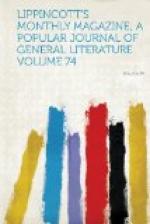Those who know Mr. Hare’s Walks in Rome and Days near Rome will welcome another series of Italian itineraries from the same pen. These volumes are primarily guide-books; they tell us the best hotels, the price of cabs, the distances by rail or high-road. But the parts of traveler and manual are inverted: whereas you take your Murray or Baedeker in your hand and carry it whither you list, Mr. Hare takes you by the hand, leads you in the way you should go, makes you pause the requisite time before the things you are to look at, points to every view, lets you miss no effect, does not force his own opinions upon you, except now and then when he loses his temper a little on the debatable ground between religion and politics, repeats that quotation you are vainly trying to recall, or delights you by the beauty and aptness of a new one. He gives to a course of systematic sight-seeing the freedom and variety of a ramble with a cultivated and sympathetic companion. We would not be ungrateful to that inestimable impersonality, Murray, for all are his debtors, even Mr. Hare for the plan of his books; but, remembering how, with the latest edition in hand, we have panted up four or more flights of stairs in a Roman or Venetian palace in search of a picture removed years before, we are not sorry to find him here taken to task for leaving uncorrected statements which had ceased to be true. Moreover, Murray is no guide in matters of art; his authorities are often captains of the British Philistines; while Mr. Hare generally gives all that has been said by competent judges, sometimes imperturbably recording two conflicting opinions, and leaving the reader to decide. The range of quotation is indeed remarkable, from Dean Milman to Ouida, including many writers too little known in this country, such as Burckhardt, Ampere and Street.
But it is not to the actual traveler only that these volumes will be of use and give pleasure. They are not bad preparatory reading for those who are going abroad, suggesting what should be studied beforehand; they will be dear to those who sit within the blank limits of a home in this raw New World trying to revive the fading outlines and colors of scenes which, though unforgotten, tend to mingle with the visions of Dreamland; and they are capital wishing-carpets for those who can travel only in fancy. In the introduction there is an excellent passage on the distinctive differences between the great Italian cities: “Each has its own individual sovereignty; its own chronicles; its own politics, domestic and foreign; its own saints, peculiarly to be revered—patrons in peace and protectors in war; its own phase of architecture; its own passion in architectural material, brick or stone, marble or terra-cotta; ...its own proverbs, its own superstitions and its own ballads.” Mr. Hare contrives to convey much of the characteristic impression of each town. Pretty little wood-cuts are called in to his aid, but the best illustrations




